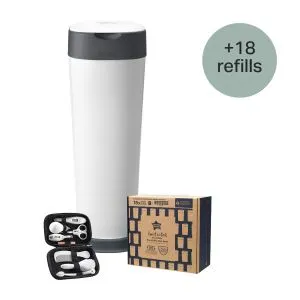
Ultimate XL Nappy Disposal Bundle with 18 Refills
Bundle & Save 40%
Subscription orders can be cancelled at anytime. Free delivery on all subsequent subscription orders. Find out more about subscriptions.
They’re easy and fuss free
Your products are automatically sent to you
You save up to 10% when you sign up for a subscription
You can cancel at any time

Bathing your newborn for the first time is one of the earliest milestones you reach as a parent, and for some, it's a daunting one!
Little ones often take a while to get used to bath time, so there may be some tears to start with. Don't worry though, not only is it necessary, but over time, bath time will become an enjoyable bonding experience for everyone involved.
This guide is here to give you the low-down on everything you need to know about bathing a newborn baby.
It's up to you as a parent to choose when to give your new baby their first bath. But it's advised that parents wait until their little one's umbilical cord stump falls off to give them what we usually think of as a bath.
In the meantime, you can wash their little one's face, neck, hands, and bottom once a day using pieces of cotton wool and warm water while they're wrapped up snugly in a towel. This is sometimes known as 'top and tailing'.
Their umbilical cord stump should be given time to dry up and fall off on its own - this usually takes a few weeks. Once it falls off, you can then transition from 'top and tail' sponge baths to actual baths in the sink or a specially designed baby bath.
Bathing your newborn baby twice or three times a week is enough. It's good to note that bathing them too frequently can dry out their sensitive skin, but you should make sure that you wash your baby's face, neck, hands and bottom daily, and thoroughly clean them after each nappy change.
It's advised that you don't bathe your baby immediately after a feed or when they're hungry. But, in terms of timing, you can bathe your newborn whenever works best for you and your unique routine, as long as they're awake and content.
There's no need to use soap or add any cleansers or bubble bath to your newborn's baths, and experts advise washing your baby's skin using only plain warm water for the first month.
Once they're a little older, it's important that the products you choose are used sparingly - a little goes a long way! Baby care products should also be mild and free from alcohol, perfume, and artificial colourings.
Before you get going with your first newborn bath, make sure the room is warm enough with no cold draughts, and that you have these essentials to hand...
Please note, that it's important that you never leave your baby unattended in the bath no matter how shallow the water is, even for a second.